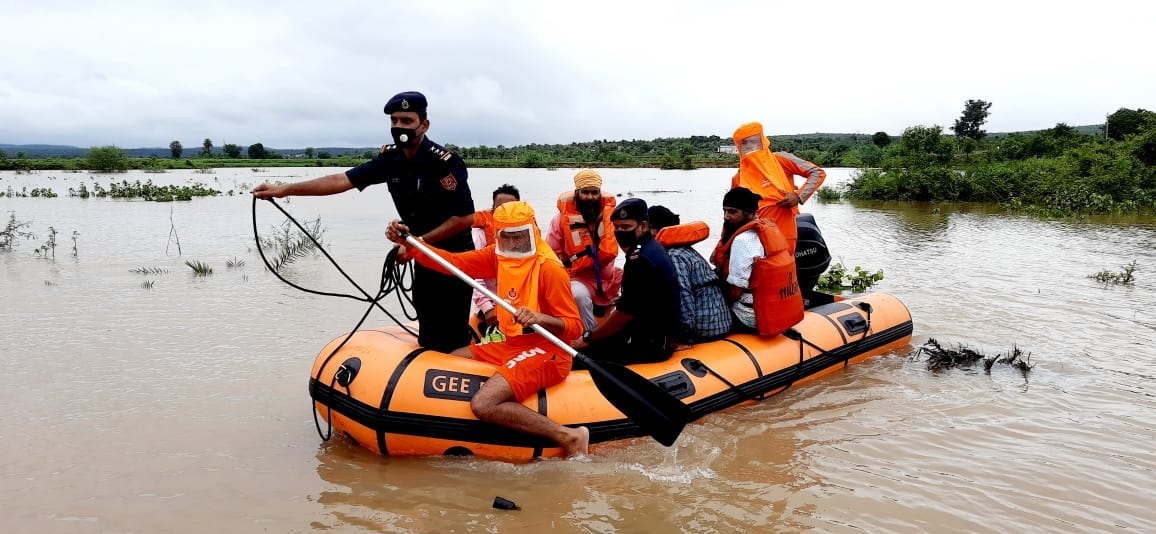
Coastal Karnataka bears brunt of heavy rain, subsequent flooding

On the night of July 22, Dongri village in Ankola, along the Gangavali river in Western Ghats of Karnataka, received unprecedented rainfall, causing flash floods in villages downstream.
Ruvu D Harikantra, a 65-year-old farmer, has a terracotta tiled-roof house in Bilehoingi village, located 2 km from the river and 5 km from the sea coast. Heavy rains in the upper region flooded the area and Harikantra’s house was submerged the next morning. Due to incessant downpour, he had to move with his family to a safer location.
Ankola taluk in Coastal Karnataka has been facing floods for the last three years. Recent rains left houses flooded and turned tiny villages into islands.
Harikantra’s house has gone under water every year since 2019. Besides suffering damage to his house, the farmer lost 2-3 quintals of rice, millet and day-to-day items in floods. The 2021 rains only made it worse for him with clothes, bed, refrigerator and grinder all getting submerged. He estimates a combined loss of ₹10-15 lakh due to heavy rains over the last few years.
Harikantra says this year’s floods were the worst. He compared it to the deluge in 1961.
In 2019, the Karnataka government announced a temporary compensation of ₹10,000 and a relief measure of ₹5 lakh for those whose houses were damaged in floods. Harikantra received ₹3 lakh of it and is still waiting for the rest of the amount. The government also said they would accommodate all the affected people in 50,000 temporary houses on rent for a brief period, but Harikanta says the benefit never came.
“While we were rebuilding the house to a livable condition, in 2020 the deluge again caused havoc. The government denied compensation saying I was a beneficiary in 2019 and so cannot get it again,” he said.
Manoj Ranjan, Director of Karnataka State Natural Disaster Monitoring Centre (KSNDMC), said that in the last three years Karnataka received rainfall which was above the average rainfall for last 50 years.
Environmentalists and climate experts indicate that heavy rainfall and subsequent flooding will lead to migration of people from semi-urban areas to cities.
Professor TV Ramachandra of the Centre for Ecological Sciences, Indian Institute of Science (IISc), says large scale land degradation with deforestation in Western Ghats are the prime reasons for natural calamities in the region.
Ramachandra’ says land degradation has reduced the water retention capacity of soil, leading to more flooding and increased instances of landslides and mudslides in Kodagu, Chikkamaggaluru, Shivamogga, Uttara Kannada and Dakshina Kannada districts. Ironically, these regions suffered scarcity of water days after rains subsided.
“Our study in the Western Ghats reveals an increase in average temperature and decline in the number of rainy days. While the quantity of precipitation (rain) has remained the same, reduced rainy days have caused high intensity rainfall followed by flooding,” Ramachandra said.
In North Karnataka, increased rainfall in catchment areas is leading to rise in water level in rivers, cause trouble in low-lying areas.
The government, back in 2009, formed a committee to study the possible effects of climate change on the region. Though the committee warned the government back then to act immediately, successive governments have ignored the report.
Also read: Heatwave effect can be cut by decongesting cities
Ramachandra suggests that large scale projects such as tunnels, road widening, setting up large scale industries, etc. need to be banned in ecologically fragile regions. “The cost of disasters (landslides, mudslides, floods, zoonotic diseases) are higher than the benefits accrued from any of the project,” he said.
Ramachandra called for action to implement ecosystem restoration approaches in managing natural resources across the country. He emphasised on dislodging the land, timber and water mafia nexus of contractors, corrupt bureaucrats and political class, who have been benefited by degradation of natural ecosystems, while depriving people of the right to life with clean air and water.
“We need to question the current paradigm of developmental path with the erroneous economic metric – GDP,” he adds. “Now is the time to develop GEP – Global ecological product through natural capital accounting and valuation of ecosystem services to ensure sustainability of natural resources with the development of the region.”
Also read: Bommai does the balancing act: 29 ministers inducted, just six new faces
Manoj Ranjan of KSNDMC said the government is trying to address the problem through MGNREGA schemes thus rejuvenating tanks, building check dams and forming weather and water committees, but individual efforts at conservation can play a key role in increasing agro-forestry belt in the region. He also laid stress on restoring ecosystems with native species of trees.
Ramachandra said that increased instances of extreme weather events in Karnataka are signs of climate change caused due to warming of the planet with escalating emissions (GHG – Greenhouse gases). “The government needs to prioritise ecosystem conservation to mitigate the impacts and sustain livelihood of people,” he adds.
A study at IISc demonstrates that villagers in the vicinity of native forests earn about Rs 154,000 per acre per year due to the availability of water throughout the year. Here, farmers can grow three crops (even cash crops) and get higher yield due to efficient pollination in the presence of diverse and abundant pollinators.
In contrast, farmers in the vicinity of monoculture plantations and degraded landscapes (with forest cover less than 30%) earn ₹32,000 per acre due to availability of water for 4-6 months and the absence of pollinators resulting in lesser yield.
Besides, regions with native species of forests have relatively lower land surface temperatures (less by 3 to 4 degrees Celsius). Thus emphasising the need to restore degraded forest patches to support livelihood and sustain water sources.
“Maintaining at least 33% green cover of native species will ensure water in the streams (and wells) throughout the year, adequate oxygen in the region, and mitigate instances of flooding and droughts,” Ramachandra said in conclusion.


